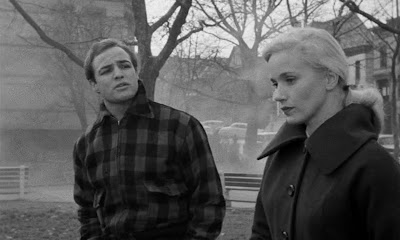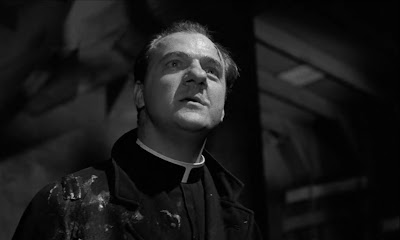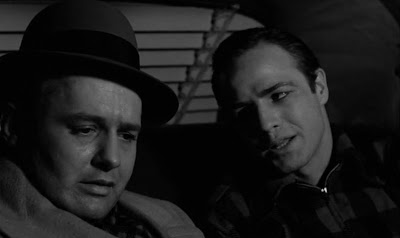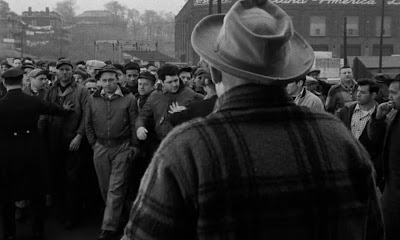 |
| Dock worker Terry Malloy (Marlon Brando) struggles with his conscience. |
Release Date: July 28, 1954. Running Time: 108 minutes. Screenplay: Budd Schulberg. Suggested by the article series, "Crime on the Waterfront," by Malcolm Johnson. Producer: Sam Spiegel. Director: Elia Kazan.
THE PLOT:
Once upon a time, Terry Malloy (Marlon Brando) was a prize fighter with ambitions of becoming a champ. Now he is just "a bum" on the waterfront. He runs errands for corrupt union leader Johnny Friendly (Lee J. Cobb), who makes sure Terry gets cushy jobs in return.
It is understood among the workers that everyone should be "D & D... Deaf and Dumb." The worst sin is to be a stool pigeon - like Joey Doyle, who has agreed to talk to the Waterfront Crime Commission about Friendly's activities.
Terry lures Joey to a rooftop, believing that Friendly's men will just "lean on" the young man to persuade him not to testify. He is shocked when he sees Joey thrown off the roof. Joey's younger sister, Edie (Eva Marie Saint), and the local priest, Father Barry (Karl Malden) team up to try to get other workers to come forward, and Terry's shame increases - particularly when he finds himself drawn to Edie.
Terry's torn loyalties do not go unnoticed. An increasingly nervous Johnny Friendly is watching - and he decides to act before Terry has a chance to turn against him!
 |
| Terry is drawn to Edie Doyle (Eva Marie Saint) - the sister of the man he helped murder. |
CHARACTERS:
Terry Malloy: Marlon Brando won his first Oscar, and it was well deserved. Brando's performance is well thought out. Through the first half of the movie, Terry puts on a tough and cynical persona, insisting that "everybody's got a racket." But this seems ever so slightly forced, like a weak man putting on a swagger, while he seems most relaxed and authentic when dancing with Edie or taking care of his pigeons. He also slouches for much of the movie and, in conversation, avoids meeting the eyes of the people he's talking to, almost perpetually conscious of shames both recent (Joey) and from the past. It's only after he decides to act that he carries himself upright; and in his final confrontation with Johnny Friendly, he looks his adversary dead in the eye.
Edie Doyle: Eva Marie Saint also won an Academy Award as the murdered dock worker's sister. In this case, I can't agree with the award. Saint does a fine job with what she's given and has good screen chemistry with Brando. That said, Edie isn't a fully formed character. She acts as a catalyst for first Father Barry and then Terry to act, and of course she's there to be the requisite love interest/eye candy. But as a person in her own right, she never seems as authentic as any of the male characters.
Father Barry: Karl Malden, Lee J. Cobb, and Rod Steiger were all nominated as Best Supporting Actor... and all of them lost. The studio should have thrown its weight behind just one of the three; and in my opinion, that one should have been Karl Malden. His Father Barry is first seen at the crime scene, offering empty clichés to try to comfort Edie. It's her snapping at him for "hiding in a church" that prompts him to come down to the waterfront. He's appalled at what he sees, wondering why the workers don't complain to the union about Friendly's abuses. He offers his church as a safe meeting place, and he draws some of the workers to him with self-deprecating humor. By the midpoint, he seems to just fill the friendly priest trope. He bursts out of that trope midway through the film, with a showstopping speech in which he excoriates the dock workers for their silence. His voice rising with genuine fury as the others shout him down and pelt him with filth. When one man calls for him to go back to his church, he thunders back: "This is my church!" The rage is a sharp contrast with his earlier laid-back persona, and Malden nails every beat.
Johnny Friendly: The corrupt union boss, who came to power by being tough and ruthless. He proudly shows off a scar where his throat was cut during his struggle to reach the top, while an underling talks about how he "kept his hand over his throat to stay alive and still went after them." Friendly is relaxed only once in the movie, in his first scene, when he thinks that Joey's death makes him safe. Once Father Barry comes to the dock, he feels his power slipping away. From that point on, his every decision is guided by fear that the workers might turn against him. He worries that he'll be seen as soft and that he'll become "just another fellow around here." Since he came to power through violence, that becomes his solution to everything - and it turns against him. By the end, he loses the fragile support he once had, with his greatest fear realized: that in the eyes of the men who once feared him, he is now "just another fellow," one whose bluster and threats can be safely ignored.
Charley Malloy: Rod Steiger would often turn to ham late in his career, making it particularly noteworthy just how subtle his performance is here, as Terry's smart but corrupt older brother. Charley isn't the focus of any of his scenes, and Steiger is constantly reacting, either to Brando or to Lee J. Cobb. But he pitches those reactions perfectly, drawing enough attention to himself in scenes to keep from being invisible while at the same time allowing his co-stars to retain the focus. Watch him during Brando's famous "I shoulda been a contender" speech. Charley already knows what Terry is telling him, even as he tries to deflect blame. He wants to deny responsibility, but he ultimately can't. The way his face and body language changes throughout the scene is nothing short of remarkable, with each new statement hitting him in a slightly different way. Steiger's career would span another 47 years until his death, but this would remain among his very best performances.
 |
| Father Barry (Karl Malden) delivers a sermon, one that's as angry as it is heartfelt. |
THOUGHTS:
Much has been written about On the Waterfront over the decades. It has been recognized as an outstanding motion picture since its initial release, and it is regularly cited among the best American movies. It has been recognized by entities as diverse as the American Film Institute and the Library of Congress, and it even made the Vatican's list of the top 45 films of all time. Even more than most of the Academy Award winners in this review series, there is zero chance that I will find anything new to say about this motion picture.
Elia Kazan directs with a focus on authenticity. Certain moments, as the camera lingers on men leaning against a wall or on the faces of workers waiting to find out if they've been selected for the day's work, are almost documentary-like. He uses the crowds throughout, with many of the film's most significant moments framed with the actors amongst large numbers of workers, letting us absorb the reactions of the people watching.
This emphasizes that the conflict engulfing Terry, Father Barry, and Johnny Friendly will not really be decided by them, but by the workers themselves. Johnny might intimidate them with threats; Father Barry might sway them with his words; Terry might earn their scorn with one action or impress them with another. In the end, however, whoever wins the crowd will win the battle. Terry is oblivious to this, but both Father Barry and Johnny recognize the reality. These crowds are particularly well used during Father Barry's speech and - still more powerfully - in the movie's final scene, which I won't describe because I wouldn't want to blunt its impact for anyone who hasn't seen the film.
There are some interesting uses of sounds within scenes. In the movie's second half, Terry finally reveals to Edie the role he played in her brother's death. We hear little of the conversation. We don't need to hear it; we've observed Terry's internal struggle throughout the movie. At first, we just watch from a distance, from Father Barry's viewpoint. Even when Kazan cuts to close-up for the emotional high point, he withholds most of the dialogue. We hear a few snatches of words, but most of what is said is drowned out by the whistle from the waterfront. Instead of words, the meaning is conveyed by the actors' faces: Eva Marie Saint, horrified as she absorbs this revelation; Brando's eyes, pleading for her to understand. It's all much more effective than if it had played out through dialogue.
One aspect of the film I didn't love was the music. Leonard Bernstein's score is good... but there's too much of it. The wonderful scene in the taxi between Terry and Charley doesn't need music, and it would in my opinion be even stronger without the score. Other moments, such as a late conversation between Terry and Edie, have the music so loud that it overpowers the dialogue. The effect isn't artistic, as with the whistle; it's just annoying. It certainly doesn't stop this from being a great film. Still, I would have preferred less music, at a less overbearing volume.
 |
| Terry appeals to his brother (Rod Steiger) in a genuinely iconic scene. The performances remain outstanding. |
ASPECT RATIO:
On the Waterfront was the first Best Picture winner to be released in widescreen format... with an asterisk. Because theaters were converting to widescreen at this time, the film was framed to be releasable in all of the common aspect ratios. It was released in standard full frame, in 1.66:1, and in 1.85:1, with no one "preferred" version ever identified by the director. This recalls the way silent versions were prepared of several early sound films (such as All Quiet on the Western Front and Cimarron).
The Criterion Collection release, which was the basis for this review, includes all three. I opted for the 1.66 version, as it strikes me as the best of both worlds. The only aspect ratio I would argue against is the 1.85, which I think boxes the faces in to a distracting degree in some close-ups. Regardless of preference, I'm happy that Criterion has allowed viewers to make their own choice.
In any aspect ratio, there's really no way to go wrong watching this fine film.
 |
| The shooting style focuses on authenticity, with moments that look almost like they belong in a documentary. |
REMAKES AND RETELLINGS:
In 1984, writer Budd Schulberg adapted his screenplay to the stage. Watching the film, I can see how this would work, as most of the action can easily be routed to either the waterfront or Terry's rooftop with minimal revision. There was also a direct remake, in the form of director Vikram Bhatt's 1998 Indian film, Ghulam (which was itself later remade).
OVERALL:
On the Waterfront stands up as a very fine film boosted by excellent performances. Marlon Brando's performance here is every bit as good as its reputation, and he's backed by a top-notch supporting cast, while Elia Kazan's direction carefully focuses on making events and characters feel as authentic as possible.
Overall Rating: 10/10.
Best Motion Picture - 1953: From Here to Eternity
Best Motion Picture - 1955: Marty
Review Index
To receive new review updates, follow me:
On BlueSky:
On Threads:


No comments:
Post a Comment